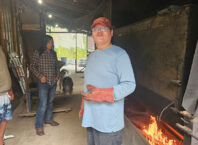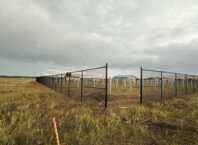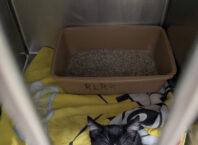By Winona LaDuke
I recently spoke with seventeen-year-old Keeya Wiki about the first descent of the Klamath River, a 263-mile river in Oregon and California. Keeya, who is Yurok and Māori, was one of thirty youth who kayaked the river for the first time in one hundred years. She reminded me of what it feels like when you protect something sacred.
In 2024, four dams came down on the Klamath River, the largest dam removal in U.S. history, and the river was free. The youth trained for the descent on white waters throughout the region, and even in Chile, to make sure they were safe. Then this summer they joined the river and traveled for a month of freedom, joy, and renewal as the youth were met by their community members at the mouth of the river.
Wiki comes from a Yurok family which had been battling to restore the Klamath for decades. Native people, as she remembers, have been “jailed, beaten and killed for fighting for this river,” she said.
“We really do carry history and trauma on our backs,” Wiki told a reporter. “Paddle Tribal Waters is completely changing this narrative from fear and anxiety to fun and smiles and giggles,” Wiki said. “We’re changing an entire generation’s story. It’s like a deep breath where I can see the world how I want to see it and not be questioned for it. … I’m my highest, happiest self on the river.”
In 2024, the Klamath River Restoration Project became the largest dam removal in U.S. history, freeing a river, and a salmon — nur, the fish of a people. The Klamath River winds 263 miles from the volcanic Cascade Range to the Pacific in Northern California. The Klamath River was once the third-largest salmon-producing river on the West Coast, with a basin of 9.4 million acres. Dams kill salmon. The Hoopa, Karuk, Klamath, Modoc, Shasta, and Yurok have thrived in this bountiful watershed for thousands of years, the river providing both physical and spiritual sustenance. They are upriver and downriver people. The river, Heyhl-keek ‘We-roy in Yurok, is the center of their lives.
That epicenter was to become an industrial energy producer with the installation of massive dams beginning in 1918: the J.C. Boyle Dam, Copco No. 1 Dam, Copco No. 2 Dam, and the Iron Gate Dam. The dams were massive tourniquets. The salmon died off, hitting their heads against the iron gates, and the warming water in the river from hotter temperatures and stagnant pools caused massive kills of more salmon — a heartbreaking 70,000 of them bellied up in a 2002 disaster.
The people did not leave their river or end their dream. Litigation, prayers, Earth Renewal ceremonies, endless negotiations with Berkshire Hathaway and Pacific Power and Light, persistence through ten or more presidents — this is how they won.
In 2019, the Yurok passed a resolution granting the Klamath River legal personhood, making it the first river in North America to receive such rights under tribal law in the “Rights of the Heyhl-keek ‘We-roy Ordinance,” formalized in 2024 to establish and implement these rights.
This initiative provides a legal framework, rooted in Yurok culture and Indigenous law, to protect the river’s health, natural evolution, and a stable environment free from pollution and human-caused climate change impacts. (This is similar to a resolution passed by the White Earth Anishinaabe recognizing the rights of wild rice, or manoomin.) The Klamath Tribes hold the most senior water rights in the Klamath Basin, meaning their rights to water are senior to other rights, including agricultural water rights for upstream farmers.
The loss of the salmon meant a loss of nutrients and life. Over the last hundred years, these landscapes have been drastically altered. After the first dam began operating in 1918 — one of four that would eventually be forged in the lower Klamath to provide hydroelectric power to nearby communities — the course of the river was changed. The dams obstructed the migration of salmon and other native species, which help carry nutrients into the systems from the ocean, with cascading effects.
This is the first time in 100 years the river has been dam free. Amy Bowers Cordalis, attorney for the Yurok Tribe, talks about the deep transformation spiritually and emotionally: “I thought we were going to be the generation that witnessed the collapse and complete death of the river. … But now we will be the generation that sees the rebirth and restoration of our ecosystem, our culture and lifeblood.”
Already it’s been among the most hopeful environmental stories of recent years. “It has been more successful than we ever imagined,” said Ren Brownell, the spokesperson for the Klamath River Renewal Corporation, a nonprofit created to oversee and implement the removal, adding: “There’s an incredible amount of joy.”
Then came the land back. First, 2,800 acres of land sacred to the Shasta Indian Nation that had been drowned under a reservoir was returned to them. Native seeds that had been strewn along the bank reemerged. And in June of 2025, the Yurok Tribe, California’s largest federally recognized tribal nation, reclaimed 73 square miles of land — or 47,097 acres — along the eastern side of the lower Klamath River. That’s the largest single “land back” in California history, the result of work with the Western Rivers Conservancy and California state agencies with the tribe. The 73 square miles of land is now owned and managed by the Yurok Tribe as the Blue Creek Salmon Sanctuary and Yurok Tribal Community Forest. By 2025, coho salmon were seen on the river for the first time in many years.
Take a Breath
It is Coos territory, a place where once shellfish were in huge abundance, deep brackish estuaries and coves teemed with fish, birds, whales, seals, and more. The tall trees once stood here; the forests are small now, but the water remains. This is the place where the Coos, Lower Umpqua, and Siuslaw people are from. It is peaceful looking out on the bay, a long hook of complex channels and an ecosystem which was threatened with the Jordan Cove Pipeline Project.
That Canadian pipeline project did not happen, and it will not happen. Take a breath. And then another. Be grateful and listen to the birds, not the sound of a combustion engine, an oil pipeline project. Take another breath — they are not here.
Sometimes silence is everything. Sometimes, the people fight hard, and they win. The Jordan Cove Pipeline was one of several Canadian oil pipelines, in this case liquefied natural gas, headed to the coast. This is the Pacific Coast, and this oil was headed to China. That’s some super explosive stuff. And it came from the dirtiest oil in the world and into a complex estuary system of shellfish and fish. That’s a bad idea.
So bad, Pembina, the Canadian company, received exemptions to kill marine mammals and trash ecosystems. NOAA, the federal agency, issued an “authorization to take marine mammals incidental to pile driving associated with construction of the Jordan Cove Liquefied Natural Gas (LNG) terminal and ancillary projects.” That’s some ecologically violent action. And that’s in part why it didn’t happen. Oil destroys life.
The Jordan Cove Pipeline project, and the Northern Gateway Pipeline (Enbridge’s tar sands to Kitimat, B.C.), did not happen, nor did the Constitution Pipeline, Enbridge Sandpiper, or the Keystone pipeline across the Dakotas. Sometimes the people, the water, and the land win. There are places where there are no pipelines.
The Jordan Cove LNG Export Terminal and pipeline battle was fought for more than fourteen years — from 2007 to 2021. This was a 229-mile-long natural gas pipeline that would have run from Malin, Oregon, on the California border, over the Coast Range to Coos Bay. The gas would then have been super-cooled into a liquefied form (LNG), loaded onto ships, and exported to Asia. That’s a lot of energy, a lot of oil, and a lot of dangerous stuff. And it’s not there. On December 1, 2021, the pipeline project was cancelled. Pembina, the Calgary-based corporation, pulled the permits and notified the federal agency that they would not continue.
This was a battle fought by Indigenous nations and grassroots organizations. And it’s worth it. It’s worth it to walk out on land and see the wild things there, to see life as it should be. Sadly, the Trump Administration is looking to revive a project which should have never been proposed.
Where There Is No Mine
This past spring, I went to visit Mole Lake Reservation in Wisconsin for a Cannabis Summit, where Tribal Chairman Robert Van Zile pointed out a mine which never happened. That was the Exxon Crandon Mine. That was a 28-year battle of the Sokaogon Anishinaabe against the largest mining corporations in the world. That’s to say, there’s a big ore deposit under and adjacent to Mole Lake, the heart of their territory. That ore attracted the attention of Rio Tinto Zinc (the same company trying to build the Tamarack Mine near Sandy Lake and the Apache Oak Flats Mine).
As Al Gedicks, a sociologist who worked with Van Zile and the tribe, explained: “The victory over the proposed metallic sulfide mine was significant not only because a grassroots group defeated what was the world’s largest energy company (Exxon) and the world’s largest mining company (BHP Billiton), it represented the emerging power of alliances between Native American tribes, environmentalists and sportfishing groups that later worked together to block other destructive projects…”
As to be expected, Gedicks points out that “The mainstream political consensus at the time was that the mine was inevitable, given the large size of the zinc-copper deposit, promised jobs and taxes, as well as Exxon’s political influence in the state…”
Sometimes the people and the wild rice win. In this case, years of litigation, environmental challenges in federal court, and finally, in 2002, the Mole Lake Ojibwe and the Forest County Potawatomi tribes purchased the 5,000-acre Crandon mine property and mineral rights for $16.5 million. Land back ended the story. The land is now managed as a conservation area devoted to sustainable land-management practices, tribal cultural values, and tourism suitable to this environmentally sensitive area.
I stood there with Robert Van Zile and looked at the land and did not hear the sound of a big truck or a tree falling. I took a big breath, because sometimes we win. Remember that.







